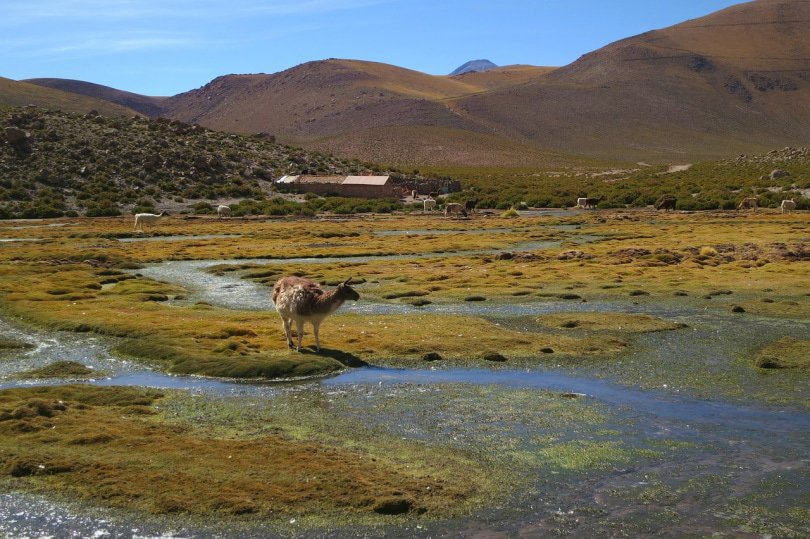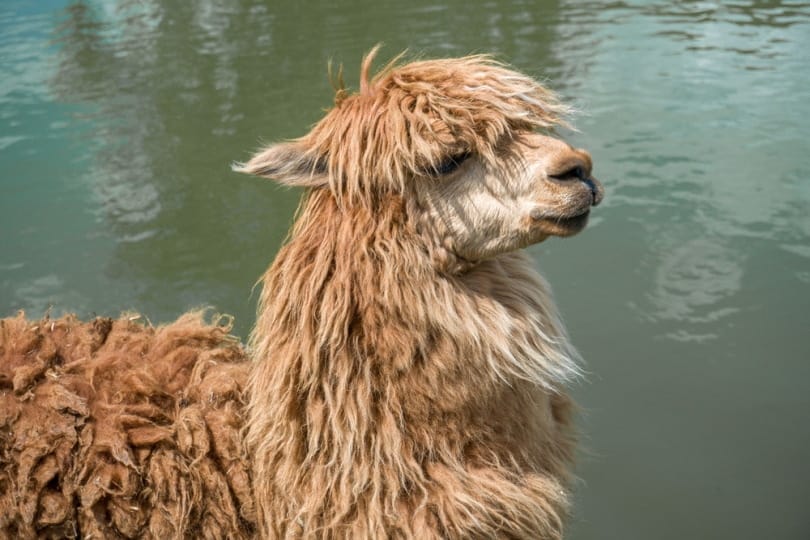Used for centuries as pack animals in South America, Llamas are unique animals that are friendly, intelligent, and easy to train. In the Western United States, llamas guard herds of sheep and goats from predators. Llamas are hardy creatures that can carry heavy loads on their back and travel several miles in rugged terrain, but can llamas swim? Yes, llamas can swim, and they seem to enjoy the activity.
Llamas love wading in shallow pools and cooling off, unlike their camel cousins. If it likes the water’s condition, it slowly walks into the pool but does not submerge its head. Although they love water, they’re not fond of getting their heads wet, and they keep their heads high above the water line when swimming. Llamas are not graceful swimmers, and they’re more skilled at swimming in shallow waters than deep pools.

Why Do Llamas Swim?
Llamas go swimming to escape the heat during the summer months, and they’re happy when they can spend most of the day submerged in water. The furry beasts maintain their internal body temperatures by releasing heat from their bellies, and when they go for a swim, they typically move to an area that’s deep enough to keep their bellies underwater. They’re less likely to go swimming in cooler months, but they’re more tolerant of harsh weather and extreme temperature changes than other domesticated farm animals.

Are Llamas Natural Swimmers?
Llamas are water lovers, but they’re not natural swimmers. When you examine the animal’s body structure, density, and thick coat, you realize that the creature does not have any genetic advantages that aid in swimming. Compared to cattle and horses, llamas have less body fat and are not buoyant. Before their hair becomes saturated with water, it provides temporary buoyancy. Llama hair is made of hollow tubes that help absorb moisture away when the animal becomes overheated, but when the hair is soaked, it loses buoyancy and only weighst he llama down.
Their swimming is more sporadic than other farm animals; they often run in the water and splash around until they settle down to soak their bellies. They may look awkward, but the creatures are confident swimmers when wading in shallow water. Deep water is hazardous for young llamas that have not been trained to swim by a breeder or trainer. They can drown when their hair becomes waterlogged while swimming in deeper water. However, llamas are intelligent creatures that do well with training, and they can eventually learn to navigate deep water safely.

What Hazards Does Swimming Pose to Llamas?
Until llamas are accustomed to swimming in different water depths, they should be supervised carefully to avoid drowning. Most llamas will not seek out deeper water since they enjoy standing in water up to their bellies and prefer to keep their heads dry. However, a young llama can become frantic if it ventures too far into the deeper areas and cannot move easily when its fur is weighted down. Since llamas are heavy animals, caretakers should have someone accompany them on swimming trips to assist in a possible emergency.
On a blazing summer day, a llama would rather stay in the water until sunset, but a long soak can be hazardous to its health. Ponds, lakes, and rivers contain contaminants and parasitic organisms that can flourish in the animal’s wet fur. Llamas have a fine, fibrous undercoat that absorbs water quickly, and when it’s submerged for long periods, it’s more vulnerable to disease. If a llama can dry off its fur after a long swim, it’s less likely to suffer from complications from a waterlogged coat.
Rain rot is a common illness for llamas caused by bacteria that live dormant on the skin for long periods. Symptoms of rain rot include spots of dry, bare skin, crusty scabs, and small pustules. Untreated, the condition can improve on its own if the fur stays dry, but shampoo containing keratolytic components can accelerate the healing and eliminate the bacteria.


How Are Llamas Used in Farms?
In South America, llamas are used to carry equipment in the Andes Mountains range, and their fur is used to make carpets, clothing, and other textile products. They’re also processed for meat, but their meat is less popular outside of South America. In the United States, llamas serve several purposes. They’re reliable pack animals that travel with hikers on long expeditions in western mountain ranges, and their fur is used to make clothes and textile products. In 1984, the United States ended its importation ban on llamas, and the creatures were imported from Chile. They soon became livestock guards for sheep and other herd animals. Llamas are not aggressive, but their imposing stature is enough to keep coyotes and feral dogs away. Llamas are protective of their herds, and some seem to treat other species like members of their families.
They’re also used as show animals and pets, and recently, more hospitals and rehabilitation centers have begun using the creatures as therapy animals. While most people think of dogs and cats as the top animals for therapy, llamas are friendly and curious animals that love to approach humans and interact with them.
How Do Llamas Behave in Captivity?
If they’re kept healthy and well-fed, llamas are affectionate to humans and other animals. They’re not aggressive to other species, but the males frequently challenge each other to establish dominance. Unlike other animal hierarchies, the llama’s social status is more fluid. The alpha animal does not stay the leader for long, and a showdown for dominance can quickly change the animal’s standing in the herd. Llamas will kick, spit, and even bite each other to establish dominance, but the ritual rarely results in injuries.
Llamas can spit undigested food at rivals up to ten feet away, but they rarely attack humans. An assault on a human is usually the result of a mistreated animal living in undesirable conditions.


Final Thoughts
Llamas are extraordinary animals that can carry heavy loads for several miles, but when they’re overheated, they enjoy taking a dip in a cool body of water. Floating in water helps them lower their body temperatures, but extended bathing periods can be detrimental to their coat and skin. Swimming sessions should be limited to a few hours to prevent bacterial infections, and llama owners must monitor young llamas in the water to avoid injuries or drowning. Whether you keep llamas as pets or working animals, they make fine additions to any farm or homestead.
Featured Image Credit: hbieser, Pixabay
